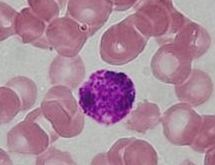Basopenia
| Basopenia | |
|---|---|
 | |
| A peripheral blood basophil stained with a Romanovsky stain. | |
| Specialty | Hematology |
Basopenia (or basocytopenia) is a form of agranulocytosis associated with a deficiency of basophils.[1] It has been proposed as an indicator of ovulation.[2] It is difficult to detect without flow cytometry, because normal levels are so low.[3] It can be defined as less than 0.01 x 109 / L.[4] Basopenia has been observed in a number of conditions, including after the administration of corticosteroids and in disease states such as chronic urticaria and lupus.[5]
Mechanism
Basophils, which account for a small proportion of the total leukocyte count, are phagocytic. Heparin, histamine, and serotonin are found in the basophilic granules. Mast cells are tissue basophils that are similar to blood basophils. Mast cells are normally not found in peripheral blood and are only rarely found in healthy bone marrow. Chronic inflammation is assessed using basophil counts. Although there is a positive correlation between higher basophil counts and high blood histamine concentrations, this correlation is not indicative of cause and effect.[6]
Associated conditions
- Hereditary absence of basophils (very rare)
- Elevated levels of glucocorticoids
- Hyperthyroidism or treatment with thyroid hormones
- Ovulation
- Hypersensitivity reactions
- Anaphylaxis
- Drug-induced reactions
- Leukocytosis (in association with diverse disorders)
References
- ^ "Definition: basophilic leukopenia from Online Medical Dictionary".
- PMID 9055113.
- ^ "CLS_3223_Unit 03_WBC". Archived from the original on 2009-01-30.
- ^ "Pathology".
- PMC 9327101. Retrieved November 14, 2023.
- ISSN 1558-447X. Retrieved November 16, 2023.
- S2CID 2935740.
- S2CID 30477970.
- PMID 9433937.
